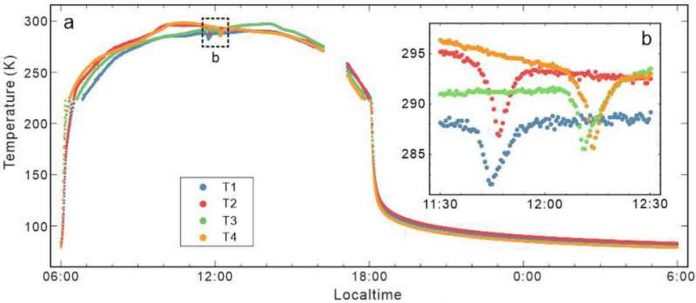Lunar regolith is a layer of loosely packed rocky grains deposited on the lunar surface, the physical and chemical properties of which are critical for deciphering the geologic history and designing lunar spacecraft. Since the Apollo era, there has been a lot of interest in determining the thermal conductivity of the lunar regolith. Early measurements concentrated on Apollo regolith samples, but experimental data were only available at a few nearside landing sites.
On January 3rd, 2019, the CE-4 spacecraft touched down at 45.4446°S, 177.5991°E on the floor of Von Kármán crater. The Yutu-2 rover was released after landing using the two rails that had been deployed. Every 900 seconds, four temperature probes beneath the rail terminals began measuring the temperature of the local regolith. “It was incredible to have contact temperature measurements of the far side regolith for the first time,” says Dr. Jun Huang, one of the study’s leaders from China University of Geosciences in Wuhan.
The particle size of the lunar regolith at the CE-4 landing site was found to be 15 m on average over depth, indicating immature regolith beneath the surface. Furthermore, the conductive component of thermal conductivity is measured to be 1.5310-3 W m-1 K-1 on the surface and 8.4810-3 W m-1 K-1 at a depth of one metre. The average bulk density on the surface is 471 kg m-3, and the upper 30 cm of lunar regolith has a density of 824 kg m-3.
“These findings will provide valuable additional “ground truth” for future global temperature analysis and interpretation. It will also shed light on future in-situ temperature and heat flux probe designs “Huang claims.

The temperature measurements were analyzed by Mr. Xiao Xiao, a Ph.D. candidate at the China University of Geosciences, Dr.Shuoran Yu from Macau University of Science and Technology, and Dr. Jun Huang. The study lasted two years, beginning in 2020, and was interrupted several times by the COVID pandemic. “Building the thermal model was difficult, but I enjoyed it,” Xiao says. Even with the high-performance cluster at the Planetary Science Institute of the China University of Geosciences in Wuhan, running the thermal model takes a long time.
Xiao and Yu analysed the data and performed the thermophysical modelling. The findings were published in the National Science Review.

